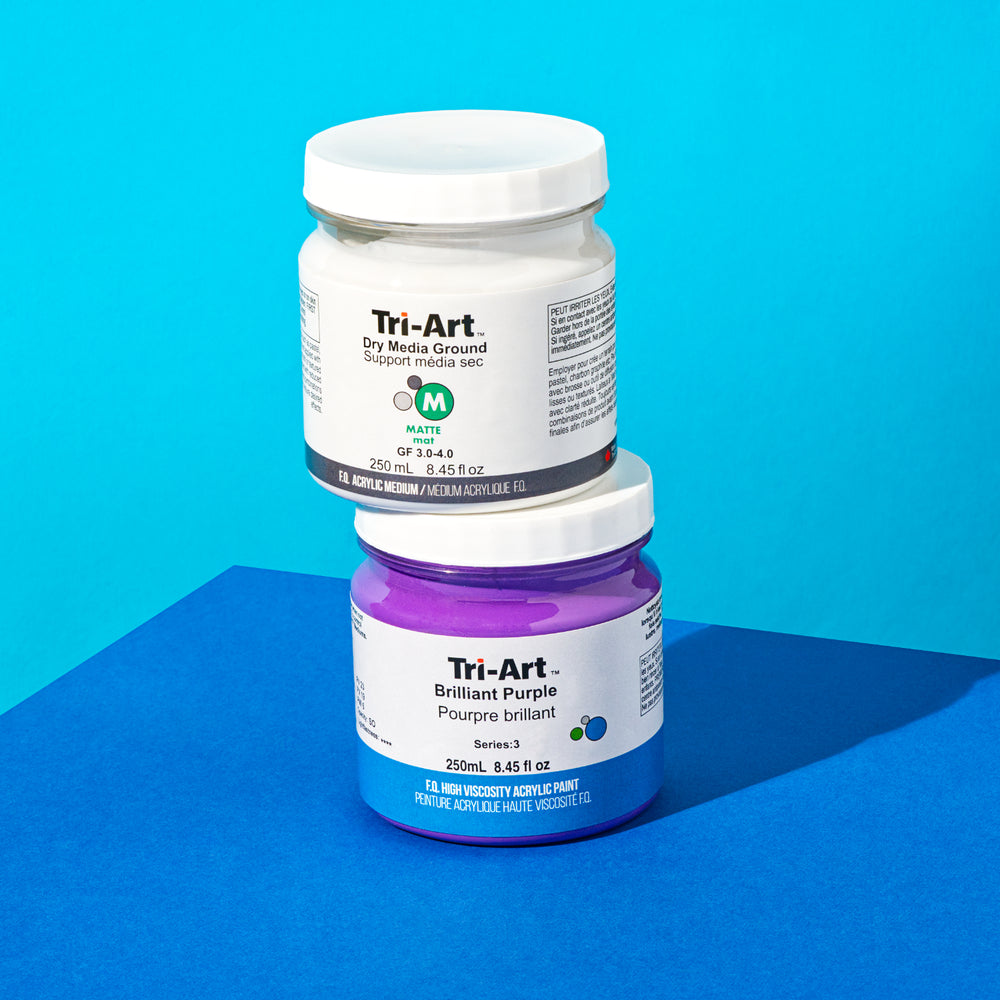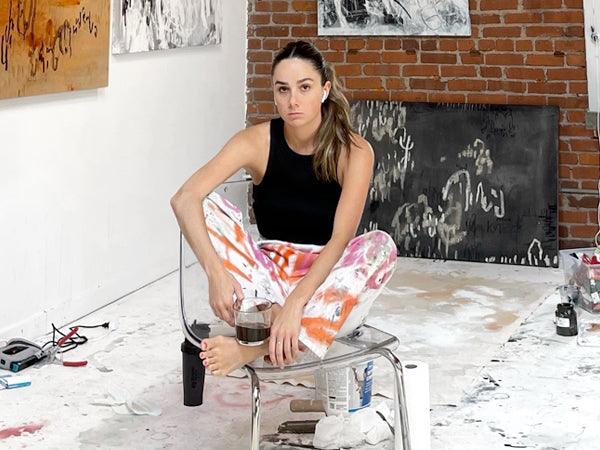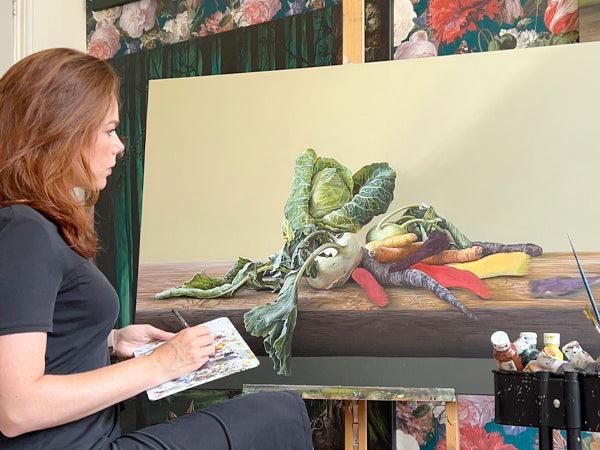Join our conversation with Celia Lees, a Toronto based abstract artist, as we talk about her work, emotional vulnerability and navigating critics.

When did your life shift to become a full-time professional artist? How did you get there?
"I have been creative my whole life. When I started painting abstract I was in university at Ryerson studying fashion design. I never felt that my creative hunger was met as an artist and the design program was too technical for me in regards to creativity. During my time at Ryerson I continued to paint while I was there, never really thinking it would become my full time job.
Eventually, I had to move overseas for work until the pandemic hit and I had to return home. With a lack of employment I turned to painting more and tried it out without any expectations. I was very fortunate to have a good amount of time to sink my teeth into the process, allow myself to ask a lot of questions, express myself and try lots of new things."

Do you use art as a means of emotional expression? How is music part of your creative process?
"In regards to emotional expression, art is the only way that I know how to express myself. I have a really hard time articulating how I feel and I struggle to find words that are representative of that.
Abstract art has allowed me to find a voice through gestures and mark-making.
I incorporate music through my creative process as I listen to it the entire time I paint. I feel as though it very heavily influences my work. Depending on the type of piece I’m working on, I’ll put on specific music to evoke emotion and energy through the physical gestures I’m using. For intense feelings I’ll put on rap music and get really aggressive with the scribbling and mark-making. Or, if I want something more light and airy I’ll put on some classical music to flow to."

Congratulations on your residency in France! What have you learned and experienced so far?
"My residency has been very refreshing, especially since its located in Provence; far away from the city. It’s been really nice and a great change of scenery. I absolutely love how the city feels in Toronto when I’m working, but having new energy to absorb into my work has been really exciting. I've been incorporating a lot more organic looking brush strokes.
I’ve also learned how sensitive my process is. Every single thing I do, experience, eat, the amount of sleep I get, the people that I’m around; it all effects how I approach my canvas. Each element alters the process to some degree. So, it's sometimes scary to have to let go of control during my process, not knowing how drastically changes will effect my work. It always surprising and allows me to explore and experiment with different techniques."

How do you navigate misconceptions like the idea that abstract art is less technical than other genres or other negative commentary?
"I don’t really navigate it at all, I always know that there will always be a place for abstract art. I have never felt that I have to vouch for it that deeply, however, I feel like that commentary comes from a place of feeling uncomfortable around abstract art because they don’t understand it.
I think that this misunderstanding comes from the fact that they don’t see anything that they can recognize within a piece and that makes them uncomfortable. I think a lot of people try to grasp at straws through abstract art by constantly looking at a piece and trying to point out specific things that appear to look like something they know.
For example, sometimes people will tell me they see different sorts of animals or faces within the piece. I think that this contextualizes the piece for them and allows them to form an opinion rather than them having to come up with something on their own.
I think people who like abstract art are okay with accepting the piece for what it is. In creating abstract art it can be challenging as you don’t have a reference point and knowledge of what you're representing.
You’re painting something that doesn’t exist or something internal onto the canvas."

What inspires your approach to abstract art; the lines, textures and consistencies you work with? Do you gain inspiration from old masters? Contemporary artists?
"I go back to the raw vulnerability of being human and looking for an emotional outlet. Personally, I work in various different styles because I have so many emotions that I feel and each one is inspired by a different feeling. Sometimes I like to create things that are foggy and soft, other times chaotic and crazy looking pieces.
The lines and textures and consistencies are all evoked from everything I’m experiencing at that time. My work is like a timestamp of my life. Some of the greats I am inspired by are Franz Kline, Cy Twombly and Willem Dekooning. Contemporary artists I am inspired by currently are Roy Aurinko, Sophie Crichton, Kane Lehanneur and Aythamy Armas."
What is the connection between your art and body? When you use your limbs as tools for applying paint, is this an intuitive or calculated experience?
"The connection between my art and my body is very close. I’m very grateful and appreciative of my body and that it allows me to move and create what it does. So, I reflect that in my practice. I’m very free when I’m painting and allow myself to really feel the moment and move around in a natural and organic way.
I feel as though it is very much intuitive rather than calculated, especially when I’m working on a larger scale and the canvas is reflective of my body and I’m able to use the entirety of me to project that onto the canvas."


As an art teacher, what is your perspective on sharing knowledge and technique?
"I feel like there is good and bad to this. If you are prepared to share knowledge and technique as a teacher you also need to be prepared to let go of control and of what happens to that information. It can become very empowering when students use that knowledge and technique that you have shared with them and run with it. This way they can build on it and make it their own.
Essentially, teaching give students tools and knowledge to create rather than a recipe to make a perfect painting which I think can be misconstrued.
It’s best when the recipient of the information absorbs from different sources and creates their own identity as an artist from that. It can be incredibly rewarding to see artists use the information that I share and use it as a stepping stone.
However, I do think there are specific things that are sacred to every artists practice in which they don’t need to share. Since we can have all the information we want with the click of a finger, there's an expectation for artists to share everything online, which isn’t always necessary.
Although there are some precautions, ultimately teaching has been a really positive experiecne and source of learning for me and I’m very grateful for it."
What are you most looking forward to in your upcoming plans and projects?
"I love anything new and refreshing, so I tend to jump at new opportunities for the experience and to learn. Right now I’m working on potentially hosting a trip that will be a combination of both travel, workshops and mentorships to allow people to connect with myself, other artists, ask questions and learn.
I’m also really excited to be doing my first art fair in a few weeks called “Artist Project” in Toronto. I always love for people to be able to see my work in person, so I’m really excited to be able to offer a collection of my work there that I can see and discuss with people."

How do you balance your life as a successful and professional artist and the need to create media content, the pressure to create new work, selling and marketing and collaboration with other organizations, individuals or galleries? How do you prevent these pressures from directing your creative visions?
"It’s a lot to manage as one person and I feel like I often have to wear many hats. However I always prioritize the act of painting and creating work. I always work to invest my most valuable energy into doing so and then everything else follows naturally after. Though, I’m really fluid about doing everything and trust my instincts a lot of the time.
I have a lot of random different previous work experiences which has taught me a lot about shipping, marketing, professionalism and organization skills. So, having a diverse work experience has allowed me to apply those skills today which has been surprising but really rewarding. Having a natural interest in social media and content creation has been really helpful so that those tasks are more enjoyable, which I’m very grateful for."

How are you finding Tri-Art paints perform in your work?
"Very impressively, I love Tri-Art paints!
I have used Tri-Art for years, mostly the Rheotech line - which is incredible as it has a really great body to it. I used to do really heavy acrylic pieces and I wanted a lot of texture, so I would always turn to Rheotech when I would do those pieces.
However, now I like to use the Professional lines of Tri-Art paints. It’s been super fun because the quality, gloss and pigment is something I’ve never experienced in paints before to this degree. The element of gloss specifically has been an amazing element to play with in my work."






